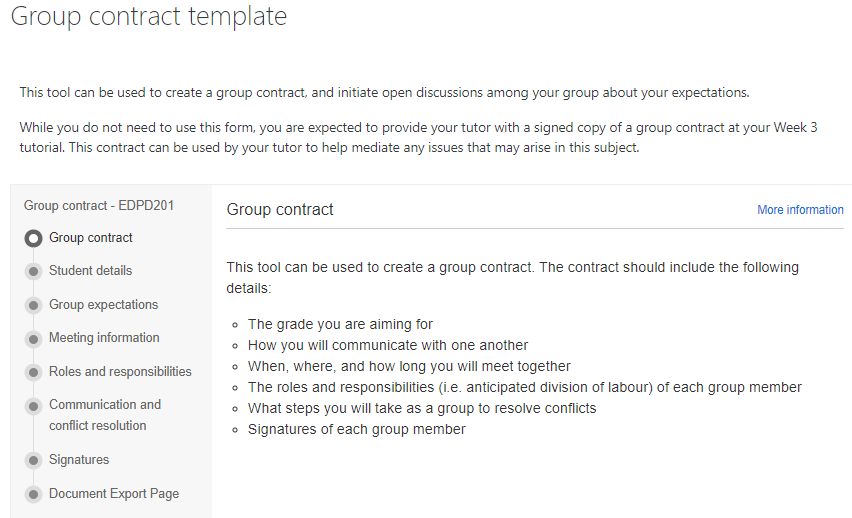Group presentations and WIL experiences online

Dr Corinne Green | Arts, Social Sciences and Humanities (ASSH)
Group presentations were an effective way of supporting peer-learning experiences via assessment, while recordings supported Work Integrated Learning (WIL) content.
Hello, my name is Corinne Green and I work with Associate Professor Michelle Eady in the School of Education and I want to talk a little bit about the online assessments that we used in Autumn 2020.
So we were quite fortunate in our subject because it was a quite easy transition to remote learning. Our assessment one of our assessment tasks has been a video for many years, and so that was very easy for students to transition to using something like zoom to capture that footage rather than being in person together to present their findings in that assessment task.
One of the things that we have found in the past and also this year, is that having a group contract is really useful. So we encourage our students to have open and frank conversations early in the semester about what their expectations are of each other in this group task. What sorts of mark there aiming for, how often they'll meet together, those kinds of things. And that can be used if the conflict does arise to bring the group back and say this is what you intend to do, this is what you agreed to, how can we get you back on the track for success for this submission.
We found that because those fringe conversations weren't happening around tutorials and lectures and things that there were a few questions that we were getting the same off. So I created a video talking to the students giving those answers. Then I only needed to give it once and the video was available on Moodle for them to refer to as often as they needed.
One of the other resources that we made available on the Moodle site where previous examples. So for one of the assessment tasks, we actually gave examples of a pass, credit, distinction and high distinction from a previous year and worked through that as one of the tutorial activities and then the students could refer back to that and really understands the marking rubric very clearly because of having those examples there.
So those are some of the things that we found really helped our students to have success in that particular subject and helps that transition to the online assessment really well. And some of those key things in there that made it easier for them as well as easier for us to manage.
Luckily, our assessments were good to go and needed little adjustment during the rapid shift to remote delivery. In previous years, our students attended weekly school visits (or, immersion days) as part of this professional development subject. However, recent changes to Professional Experience arrangements within the School of Education meant these immersion days were no longer possible. As such, steps had been taken in February 2020 to record authentic classroom practice videos for students to reflect upon and use for their assessment tasks. This really helped support WIL content in the subject material and reflective assessment tasks.
A group presentation examining three decades of teaching had been designed as a video submission over five years ago. For remote delivery, this was just filmed by students over Zoom. Some students made the most of this opportunity, editing the videos to make transitions and delivery fun.
How?
This subject had strong connections with industry (local primary schools), so recording authentic, professional interactions was relatively easy. They were shared with students with clear instructions and rubrics provided to outline how the videos should be used in their assessment. The primary schools that we worked with organised permission notes prior to filming to ensure that families gave consent for the videos to be used within the subject. There were a couple of instances where a student from a different class was captured in the recording (e.g. one girl who was delivering notes around the school). For these, the principal spoke to the family after filming to gain permission. If it had not been forthcoming, we would have edited the video to ensure that student was not identifiable. All videos were sent to the school contact and the classroom teachers for final approval prior to adding them to the Moodle site.
As the group presentations were pre-recorded and submitted as video files, the hardest part of managing this via remote delivery was managing group dynamics – which is also often the case when teaching this subject face-to-face. This was scaffolded through group contracts early in the session, where students agreed upon their expectations of results and workload. This written contract was then submitted to their tutor, so it could be used as evidence to contextualise any future disagreements. I used a H5P activity on Moodle as the template for the group contract – students fill in their details, download it as a Word doc, sign it, and upload it to Moodle (via a non-assessed Assignment Submission activity). Students were also encouraged well ahead of the due date to flag potential issues so they could be resolved.

Reflection
- Remind students to contact you early if any issues with group members come up. We make it explicit at the start of the semester, as well as during the semester, that we are much more able to help students to succeed in the assessment task if we hear about any possible issues a few weeks ahead of the due date. Our options are much more limited if we hear about it a few days before the due date, and even less so if we only hear about it after the due date.
- Provide clear scaffolds for students to understand and complete the assessment (e.g., rubrics, exemplars). For the first assessment task in EDPD201 (a critical reflection essay), we provided examples from previous years ranging from Pass to High Distinction. An early tutorial activity involved students assessing these examples against the marking rubric, helping them to understand the task and the marking rubric at a deeper level. Turnitin was used to ensure that students were not copying directly from these exemplars.
- Answer common questions about assessment tasks in a way that students can refer back to. I created a quick video explaining pertinent points and questions that arose about an assessment task and made the recording accessible on Moodle.
- Use Groups and Group Selection Activities on Moodle to make it easy to give marks to the whole group. We ask one student in each group to upload their submission; that student receives a mark and feedback which they share with their group members (who have received a mark only).
Support resources
- Clear instructions for assessment | L&T Hub resource
- Adding contextual information | L&T Hub resource
- Video Assessments | Preparing to Teach Online
- Documentation tool (H5P) | External resource



